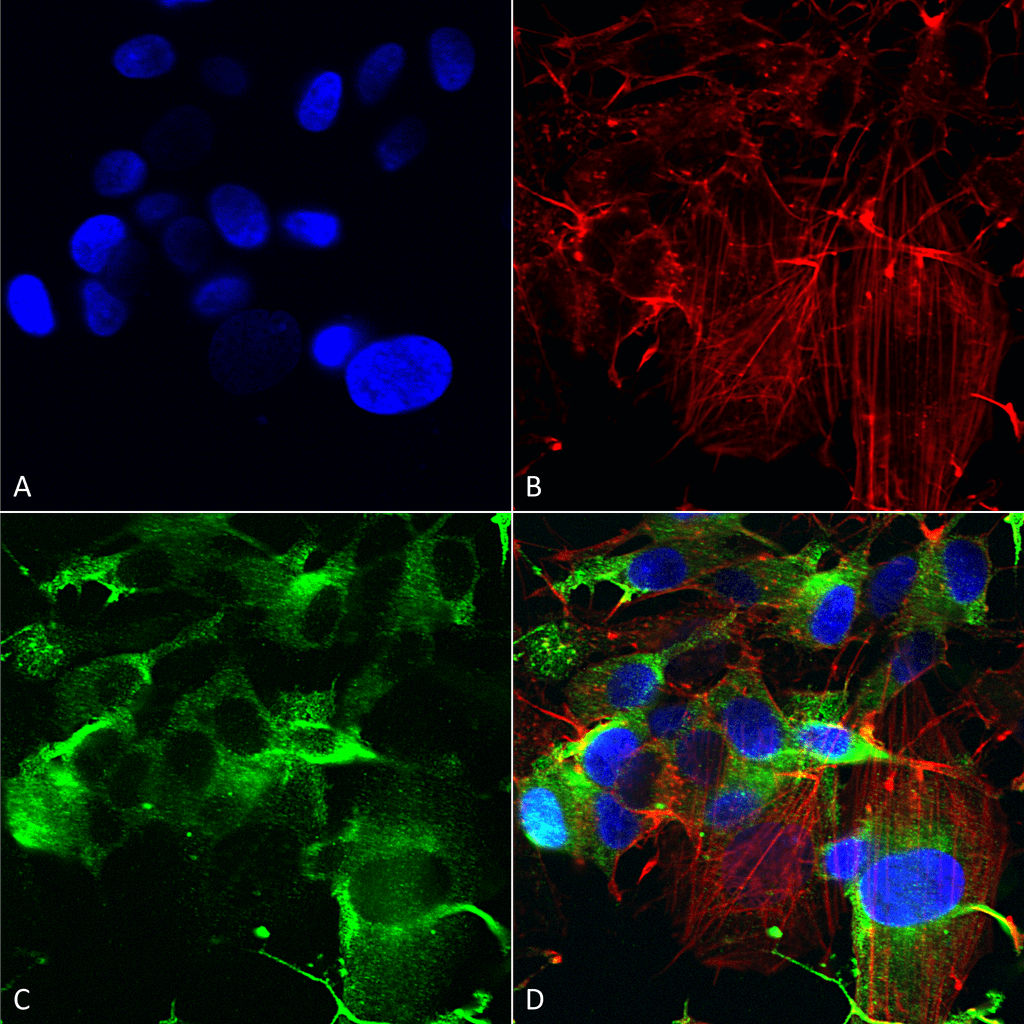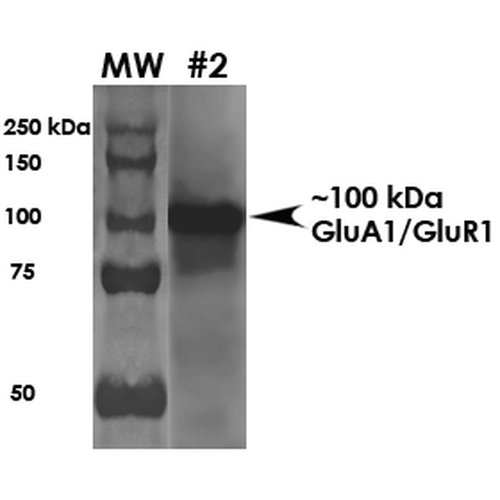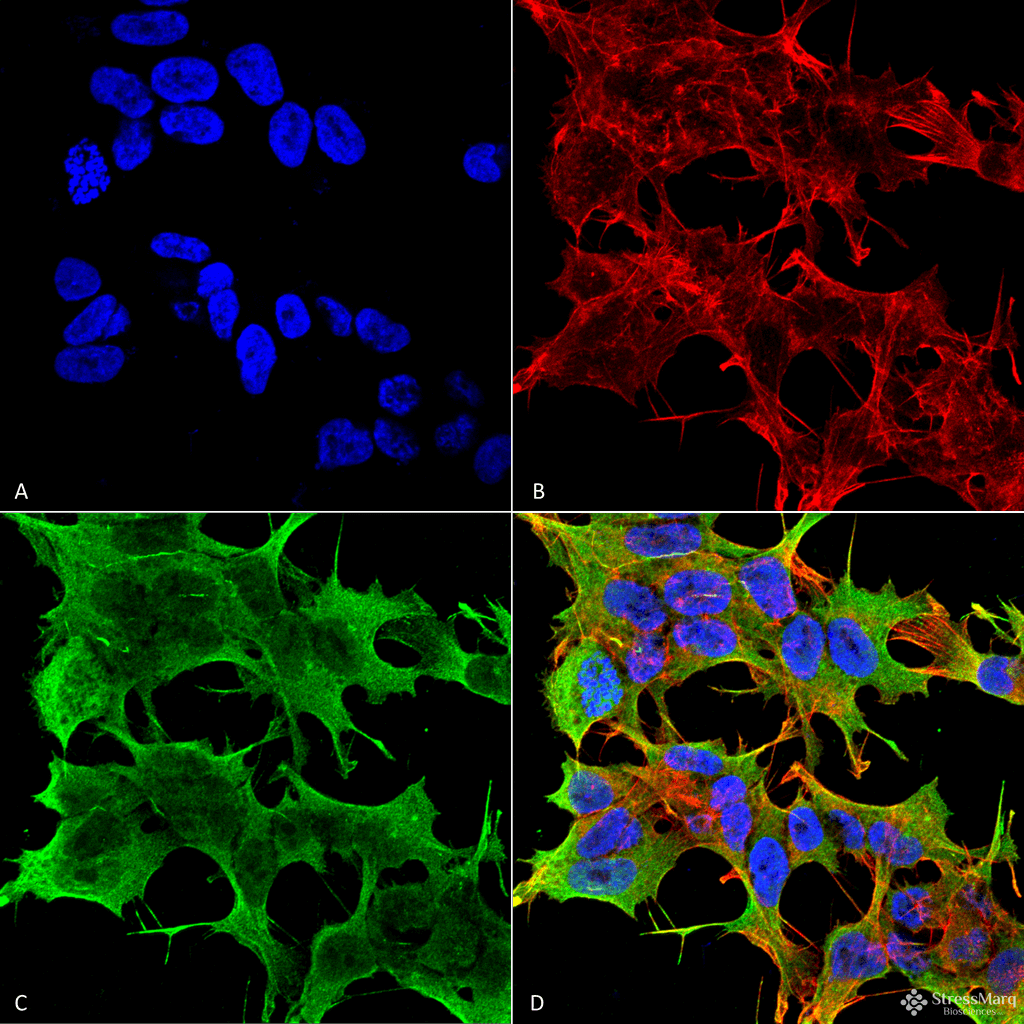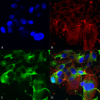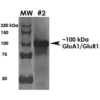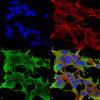Anti-GluA1-GluR1 Antibody (56547)
$466.00
SKU: 56547
Categories: Antibody Products, Neuroscience and Signal Transduction Antibodies, Products
Overview
Product Name Anti-GluA1-GluR1 Antibody (56547)
Description Anti-GluA1/GluR1 Mouse Monoclonal Antibody
Target GluA1-GluR1
Species Reactivity Mouse, Rat
Applications WB,IHC,ICC/IF
Host Mouse
Clonality Monoclonal
Clone ID S355-1
Isotype IgG1
Immunogen Fusion protein corresponding to aa 1-389 (extracellular N-terminus) of rat GluA1/GluR1 (accession no. P19490).
Properties
Form Liquid
Concentration Lot Specific
Formulation PBS, pH 7.4; 50% glycerol, 0.09% sodium azide.
Buffer Formulation Phosphate Buffered Saline
Buffer pH pH 7.4
Buffer Anti-Microbial 0.09% Sodium Azide
Buffer Cryopreservative 50% Glycerol
Format Purified
Purification Purified by Protein G affinity chromatography
Specificity Information
Specificity This antibody recognizes mouse and rat GluA1/GluR1. It does not cross-react with GluR2.
Target Name Glutamate receptor 1
Target ID GluA1-GluR1
Uniprot ID P19490
Alternative Names GluR-1, AMPA-selective glutamate receptor 1, GluR-A, GluR-K1, Glutamate receptor ionotropic, AMPA 1, GluA1
Gene Name Gria1
Sequence Location Cell membrane, Endoplasmic reticulum membrane, Cell junction, synapse, postsynaptic cell membrane, Cell junction, synapse, postsynaptic density membrane, Cell projection, dendrite, Cell projection, dendritic spine, Early endosome membrane, Recycling endosome membrane, Cell junction, synapse, presynapse, Cell junction, synapse
Biological Function Ionotropic glutamate receptor. L-glutamate acts as an excitatory neurotransmitter at many synapses in the central nervous system. Binding of the excitatory neurotransmitter L-glutamate induces a conformation change, leading to the opening of the cation channel, and thereby converts the chemical signal to an electrical impulse. The receptor then desensitizes rapidly and enters a transient inactive state, characterized by the presence of bound agonist. In the presence of CACNG4 or CACNG7 or CACNG8, shows resensitization which is characterized by a delayed accumulation of current flux upon continued application of glutamate. {PubMed:16793768, PubMed:19265014}.
Research Areas Neuroscience
Background Regulation of alpha-amino-3-hydroxy-5- methyl-4-isoxazole propionic acid receptors (AMPARs) plays a key role in altering excitatory synaptic transmission in the CNS. Interestingly, the regulatory mechanisms differ between distinct subunits of AMPAR, which range from glutamate receptor 1 (GluR1) to GluR4 (also referred to as GluA1–4). For example, subunits with a long intracellular carboxy terminus (i.e., GluR1, GluR2L, and GluR4) are involved in activity- dependent synaptic targeting of AMPAR, whereas those with a shorter carboxy terminus (i.e., GluR2, GluR3, and GluR4s) seem to maintain basal synaptic transmission. GluR1 has several phosphorylation sites on the intracellular carboxy terminus. Many of these sites have been demonstrated to play a role in synaptic AMPAR regulation and synaptic plasticity.
Application Images




Description Immunocytochemistry/Immunofluorescence analysis using Mouse Anti-GluA1/GluR1 Monoclonal Antibody, Clone S355-1 (56547). Tissue: Neuroblastoma cells (SH-SY5Y). Species: Human. Fixation: 4% PFA for 15 min. Primary Antibody: Mouse Anti-GluA1/GluR1 Monoclonal Antibody (56547) at 1:200 for overnight at 4°C with slow rocking. Secondary Antibody: AlexaFluor 488 at 1:1000 for 1 hour at RT. Counterstain: Phalloidin-iFluor 647 (red) F-Actin stain; Hoechst (blue) nuclear stain at 1:800, 1.6mM for 20 min at RT. (A) Hoechst (blue) nuclear stain. (B) Phalloidin-iFluor 647 (red) F-Actin stain. (C) GluA1/GluR1 Antibody (D) Composite.

Description Western Blot analysis of Rat Brain Membrane showing detection of ~100 kDa GluA1-GluR1 protein using Mouse Anti-GluA1-GluR1 Monoclonal Antibody, Clone S355-1 (56547). Load: 10 µg. Block: 5% milk + TBST. Primary Antibody: Mouse Anti-GluA1-GluR1 Monoclonal Antibody (56547) at 1:2000 for 1 hour at RT. Secondary Antibody: Goat Anti-Mouse HRP at 1:200 for 1 hour at RT. Predicted/Observed Size: ~100 kDa.

Description Immunocytochemistry/Immunofluorescence analysis using Mouse Anti-GluA1/GluR1 Glutamate Receptor Monoclonal Antibody, Clone S355-1 (56547). Tissue: Neuroblastoma cell line (SK-N-BE). Species: Human. Fixation: 4% Formaldehyde for 15 min at RT. Primary Antibody: Mouse Anti-GluA1/GluR1 Glutamate Receptor Monoclonal Antibody (56547) at 1:100 for 60 min at RT. Secondary Antibody: Goat Anti-Mouse ATTO 488 at 1:100 for 60 min at RT. Counterstain: Phalloidin Texas Red F-Actin stain; DAPI (blue) nuclear stain at 1:1000, 1:5000 for 60min RT, 5min RT. Localization: Cell Membrane, Cell Junction. Magnification: 60X. (A) DAPI (blue) nuclear stain. (B) Phalloidin Texas Red F-Actin stain. (C) GluA1/GluR1 Glutamate Receptor Antibody. (D) Composite.
Handling
Storage This antibody is stable for at least one (1) year at -20°C.
Dilution Instructions Dilute in PBS or medium that is identical to that used in the assay system.
Application Instructions Immunoblotting: use at 1ug/mL. A band of ~100kDa is detected.
Positive control: Rat brain lysate.
These are recommended concentrations. User should determine optimal concentrations for their application.
Positive control: Rat brain lysate.
These are recommended concentrations. User should determine optimal concentrations for their application.
References & Data Sheet
Data Sheet  Download PDF Data Sheet
Download PDF Data Sheet
 Download PDF Data Sheet
Download PDF Data Sheet

